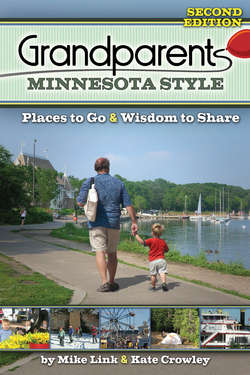Читать книгу Grandparents Minnesota Style - Mike Link - Страница 13
На сайте Литреса книга снята с продажи.
ОглавлениеGreat Lakes Aquarium
We live in the land of lakes—close to fifteen thousand of them—as well as ponds, swamps, bogs, marshes and the greatest of the Great Lakes. But what do we know about our lakes? We know we can fish, swim, boat, take pictures and build cabins. Look at the water’s surface, and what do you see? Reflections of the sky, the shoreline and yourself. But for as much time as we spend on our lakes, we know very little about what is in them.
Filled with exotic animals like mudpuppies and eelpouts, the aquarium also features birds, turtles and snakes. You can even see the notorious Sea Lamprey!
There is a section of the aquarium devoted to the story of the Great Lakes, and the aquarium is filled with wonderful information that you will not find anywhere else. It is currently Minnesota’s only large-scale aquarium, and it has some essential information for understanding the Great Lakes.
The shapes and relative elevations of these lakes are well represented, thanks to the Great Lakes Water Table. It’s a real playfest for your grandchild, as he moves floating toy boats through a model of the lakes. Add a few of your own observations to his fun, while learning some new facts yourself.
The main floor features changing aquatic displays that often depart from the freshwater realm, with such exhibits as the Abyss: a combination of aquaria, film and displays. There is also a river otter display and two large, two-story tanks of freshwater fish.
But that’s not all. Your grandchild can also touch real stingrays and sturgeons, watch the sea creatures being fed, meet Bogey the Bald Eagle (who has a wing injury preventing him from returning into the wild) and much more.
We love Minnesota for a lot of reasons. The Great Lakes Aquarium is the place to celebrate one of them.
Bonding and bridging:
The Great Lakes Aquarium lifts the curtain on one of childhood’s mysteries, revealing a hidden world that lies beneath the water’s surface. Suddenly, we’re snapped into an awareness that there are things around us which we never before noticed.
The possibilities that come with this realization are almost endless. You can use your time to discuss how our actions affect the environment—how we must be stewards of the land to save these fish habitats from pollution. Share how factories located hundreds of miles away may discharge harmful chemicals that travel to our region in air currents. These chemicals then fall into our lakes as acid rain, killing plankton that small fish feed on, thereby killing the small fish, which in turn depletes the food supply for larger fish.
The overall message here is a big one: Just because we can’t see something doesn’t mean it won’t have a huge impact on our lives or on the environment around us.
A word to the wise:
Everyone loves the action when the big fish are fed. The fish become more active, we can see them use their fins and tails, and they interact more with one another. Feeding times are posted, and each is hosted by a narrator.
Age of grandchild: All
Best season: Summer (because you can combine the visit with so many harbor experiences)
Contact: Great Lakes Aquarium, 353 Harbor Drive, Duluth, MN 55802 • (218) 740-3474 • www.glaquarium.org
Also check out:
Minnesota Zoo, Apple Valley; (952) 232-0382 or (800) 219-1855; www.mnzoo.org
Minnesota Sea Life Aquarium (Mall of America), Bloomington; (952) 883-0202; www.visitsealife.com/minnesota
The simplest toy, one which even the youngest child can operate, is called a grandparent. SAM LEVENSON
